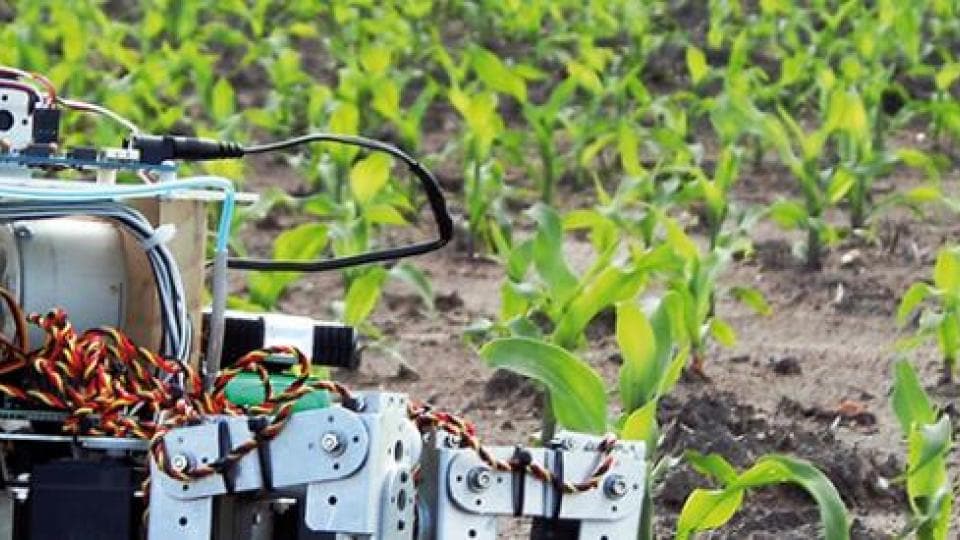Drones Revolutionize Farmer's Lives

Can you imagine spending eight hours a day navigating muddy paddy fields in hot and humid environments, carrying heavy solution in a backpack sprayer to protect one hectare of rice? This is the hard reality of the average rice farmer in Asia.
Asian rice farmers face the challenge of finding workers to do such cumbersome, but critical agricultural tasks that help prevent potentially dire consequences. In the short-term, fields left unprotected against diseases and insects run the risk of producing a lesser, lower quality yield. Long-term, the younger generation’s lack of interest in taking on this kind of manual work raises the average age of the modern farmer and threatens future succession.
What if this labor-intensive job could be done in 10-15 minutes?
Fortunately, modern technology offers the potential to alleviate some of the burdens of growing one of the world's staple crops. Bayer's future-facing mindset and commitment to open innovation have enabled drones to help drive a more productive and sustainable future for agriculture. This single innovation not only handles otherwise grueling crop protection tasks in the rice paddy, but it does so more accurately and consistently in a fraction of the time compared to manual labor.
So how do farmers use drones? Typically, one thinks of drones for their imaging capabilities. However, a battery-powered multi-rotor drone can feature an automatic filling tank designed to match exact field sizes and trace terrains through height sensors that maintain a constant distance above fields. These versatile drones can also fly and land autonomously as well as detect and avoid mid-flight obstacles.
 Drone applications in agriculture are virtually endless. With more efficient crop protection comes the potential for more sustainable management of rice paddies and comparable fields. Drone application requires less water and reduces the overall volume of solution application compared with the “cover all” strategy of most human-led spraying. Replacing a diesel-powered sprayer with an electric battery-powered drone also conserves fuel.
Drone applications in agriculture are virtually endless. With more efficient crop protection comes the potential for more sustainable management of rice paddies and comparable fields. Drone application requires less water and reduces the overall volume of solution application compared with the “cover all” strategy of most human-led spraying. Replacing a diesel-powered sprayer with an electric battery-powered drone also conserves fuel.
Taking initial flight
There are many reasons why this technology is gaining traction on farms around the world. Beyond elevating yield potential, multi-rotor drones present a faster, safer application strategy compared to hand spraying. Autonomous loading and distribution capabilities limit human exposure to crop protection solutions, and targeted overhead flight prevents interference with growers or other crops in the field.
The main advantage of drone application, however, remains the ability to apply just the right amount of treatment in the locations where it’s needed. If suitably designed, adjuvants in crop protection products can ensure a targeted delivery of active ingredients at lower spray volumes and dramatically advance farmers’ rice management potential. Additionally, we have seen how the downdraught air stream of the rotors pushes the plant canopy open so that spray droplets can reach the base of the plant to provide more efficient and comprehensive protection.
Identifying new airspace
Drones are key for sustainability—and their potential is only growing. The successes of the initial drone usage in Chinese rice paddies are capturing the attention of other global farmers and creating new opportunities for Bayer to enable growers to use drones to enhance ag processes around the world. Follow-up pilots are underway in Japan, Korea and Latin America, with other potential applications in discussion.
 In late 2020, Bayer additionally took a major step to introduce this pioneering drone technology to farmers throughout the U.S. by forming a strategic partnership with Rantizo – a software and applications developer whose platform integrates with drones to identify crop protection issues and deliver precise in-field crop input applications.
In late 2020, Bayer additionally took a major step to introduce this pioneering drone technology to farmers throughout the U.S. by forming a strategic partnership with Rantizo – a software and applications developer whose platform integrates with drones to identify crop protection issues and deliver precise in-field crop input applications.
As more growers understand and become comfortable using this technology, drone farming has the potential to accomplish even more. Based on the initial achievements in rice fields, Bayer is beginning to collaborate with growers to explore drones’ capabilities to aid in corn, sugar cane, wheat, vegetable, banana, grape and citrus harvests.
Shaping the future of farming
Industry innovators are increasingly seeing the new business opportunity in how farmers can use drones to work more sustainably. We are delighted to see how drone technology is inspiring younger generations to pursue careers in agriculture—a key development in reversing the trend of an aging farmer population. Bayer is fully committing to continually advancing this technology to help shape the future of farming in ways that benefit growers, consumers and our planet.


















